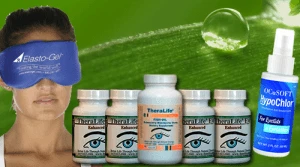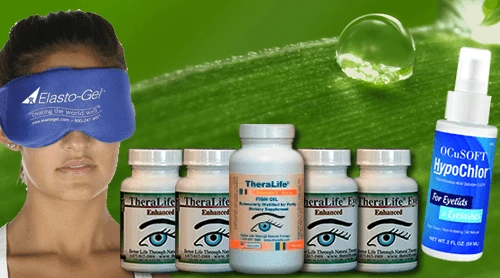TheraLife offers a range of products designed to benefit those suffering from blepharitis and other ocular conditions. Their focus on anti-inflammatory and antioxidant-rich solutions is akin to the benefits of foods like omega-3 rich fish, flaxseeds, chia seeds, and colorful berries. TheraLife products are formulated to ease inflammation and support ocular wellness, complementing proper eyelid hygiene. While these products do not provide a cure for blepharitis, they can significantly alleviate symptoms and promote eye health. Explore how TheraLife’s offerings can enhance your eye care routine further.
Best Blepharitis Treatment From TheraLife- When Drops Don’t Work.
Key Takeaways
- Flaxseeds and chia seeds, rich in omega-3 fatty acids, can help reduce inflammation and support tear film stability.
- Colorful berries, high in antioxidants, may reduce oxidative stress and support healthier eyelid margins for sufferers.
- Leafy green vegetables provide nutrients essential for general eye health but offer no direct relief for symptoms.
- Probiotic yogurt supports overall immune and gut health, though it is not proven to soothe it specifically.
- Salmon, sardines, and mackerel provide omega-3s, but their effectiveness in relieving its symptoms is not strongly supported by current evidence.
Omega-3 Rich Fish
Although omega-3 rich fish like salmon, sardines, and mackerel are often recommended for their anti-inflammatory benefits, current scientific evidence doesn’t support their effectiveness in directly soothing blepharitis symptoms.
You might encounter advice suggesting increased fish intake for eye health. However, clinical studies haven’t demonstrated a clear link between omega-3 consumption and symptom relief for blepharitis specifically.
Research shows varying sample sizes and dosages, with mixed results regarding the effectiveness of omega-3s for dry eye symptom relief, which suggests a similar lack of conclusive evidence for blepharitis symptoms.
If you choose to include these fish in your diet, prioritize sustainable fishing practices to guarantee ecological responsibility. Effective fish preparation techniques, such as baking or grilling instead of frying, can help preserve beneficial nutrients and reduce unhealthy fat intake.
While omega-3 rich fish offer general health advantages, you shouldn’t expect them to alleviate blepharitis symptoms based on current data.
Leafy Green Vegetables
Despite their reputation for supporting eye health, leafy green vegetables like spinach, kale, and Swiss chard don’t have scientific evidence backing their effectiveness in directly soothing its symptoms. You may hear that these leafy greens are packed with nutrients such as lutein, zeaxanthin, vitamin A, and vitamin C, all essential for general eye function and maintenance of ocular tissues. However, clinical studies haven’t shown that consuming leafy greens alleviates the inflammation, irritation, or meibomian gland dysfunction characteristic of blepharitis. While it’s beneficial to incorporate a variety of leafy greens in your diet for their proven systemic health effects and to potentially reduce your risk of certain eye diseases, it’s important to recognize their role as supportive rather than therapeutic for blepharitis specifically. A recommended practice for managing it involves regular eyelid cleansing with baby shampoo, which helps alleviate symptoms by removing debris and reducing inflammation.
Flaxseeds and Chia Seeds
You can support blepharitis management by including flaxseeds and chia seeds in your diet, as both are rich sources of plant-based omega-3 fatty acids.
Evidence indicates that omega-3s help reduce inflammation, which is a key factor in its symptoms.
Consistent intake of these seeds may contribute to improved ocular surface health.
TheraLife Omega-3 is purified via molecular distillation, a process that ensures the removal of contaminants like mercury and PCBs, maintaining high purity and potency.
Omega-3 Fatty Acid Benefits
Omega-3 fatty acids, found abundantly in flaxseeds and chia seeds, play an essential role in modulating inflammation within the body.
When you increase your dietary intake of omega 3 sources, such as flaxseeds and chia seeds, you may support ocular surface health and help alleviate blepharitis symptoms.
Clinical studies indicate that a deficiency in these essential fatty acids may contribute to more severe eyelid inflammation.
If your diet alone doesn’t provide sufficient amounts, omega 3 supplements can serve as a reliable adjunct to meet recommended daily requirements.
Incorporating these plant-based omega 3 sources improves tear film stability and may decrease the frequency of eyelid irritation.
Omega-3 Fish Oil Benefits include helping to thicken natural tears and prevent their evaporation, which supports overall ocular health.
Ultimately, consistent intake of omega-3 fatty acids supports your body’s anti-inflammatory pathways specific to eyelid and ocular surface tissues.
Best Blepharitis Treatment From TheraLife- When Drops Don’t Work.
Reducing Inflammation Naturally
Although inflammation is a key driver of blepharitis symptoms, dietary strategies targeting this process can offer measurable benefits. Flaxseeds and chia seeds provide high concentrations of alpha-linolenic acid (ALA), a plant-based omega-3 fatty acid shown to reduce ocular surface inflammation.
Clinical studies indicate these seeds, when integrated daily, can promote meibomian gland function and decrease lid margin redness. You can further augment their anti-inflammatory effects with herbal remedies. For example, the incorporation of turmeric—well known for its curcumin content—yields additional turmeric benefits through downregulation of pro-inflammatory cytokines.
To optimize your dietary plan for blepharitis, consider:
- Adding ground flaxseeds to breakfast cereals or smoothies
- Using chia seeds in yogurt or overnight oats
- Supplementing meals with turmeric for synergistic effects
Consider incorporating omega-3 fatty acids from cold water fish to further enhance anti-inflammatory benefits and support overall eye health.
Probiotic Yogurt
Despite the popularity of probiotic yogurt as a health food, current evidence doesn’t support its effectiveness in directly soothing blepharitis symptoms.
You may encounter claims suggesting probiotic benefits extend to eye health, yet no clinical trials have established a direct link between consumption of yogurt varieties and symptomatic relief.
Probiotic yogurt contains live bacterial cultures that support gastrointestinal health and general immunity.
However, studies focusing on ocular conditions such as blepharitis haven’t demonstrated measurable improvements from probiotic intake.
When choosing yogurt varieties, focus on overall nutritional value and live culture content rather than expecting symptom relief.
Blepharitis is a common eye condition characterized by chronic eyelid inflammation****, and maintaining proper eyelid hygiene is crucial for managing its symptoms.
Always consult your healthcare provider before making dietary changes, especially if you seek targeted support for eyelid inflammation or related ophthalmologic conditions.
Colorful Berries
You’ll find that colorful berries offer high concentrations of antioxidants, which protect ocular tissues from oxidative stress. Clinical studies show these compounds can help reduce inflammatory responses linked to it. Including berries in your diet may support healthier eyelid margins and tear film stability. Additionally, maintaining good hygiene practices can significantly reduce the occurrence of it and support overall eye health.
Antioxidant Powerhouse Benefits
Richly pigmented berries such as blueberries, raspberries, and blackberries contain high levels of antioxidants, particularly anthocyanins and vitamin C, which help neutralize free radicals associated with inflammatory conditions.
If you integrate these berries into your diet, you’re tapping into some of the most effective natural antioxidant sources available. Research demonstrates that their antioxidant effects can reduce oxidative stress, which underpins many inflammatory diseases, including blepharitis.
By targeting free radicals, these nutrients help maintain cellular health in ocular tissues. Consider the following benefits:
- Enhance cellular defense by limiting oxidative DNA and protein damage
- Support ocular barrier function through protection of epithelial cells
- Deliver measurable increases in plasma antioxidant capacity following regular consumption
Consuming colorful berries acts as a precise intervention against oxidative factors involved in blepharitis. In addition to dietary changes, warm compresses are highly recommended to alleviate symptoms, as they improve blood circulation and promote oil flow from meibomian glands, providing relief from itching, burning, and dryness.
Best Blepharitis Treatment From TheraLife- When Drops Don’t Work.
Reducing Inflammatory Responses
In addition to their antioxidant capacity, berries such as blueberries, raspberries, and blackberries demonstrate notable effects in modulating inflammatory pathways relevant to blepharitis. These fruits contain polyphenols and anthocyanins, which have been shown in clinical studies to lower pro-inflammatory cytokines implicated in eyelid inflammation. Implementing dietary adjustments that increase your intake of colorful berries serves as a practical, evidence-based natural remedy to target both systemic and localized inflammation. Regular consumption helps decrease the recruitment of inflammatory cells to the eyelid margin, reducing symptoms such as redness, irritation, and swelling. You’ll likely benefit from including a diverse range of berries in your diet, optimizing both anti-inflammatory and overall ocular health. This dietary strategy offers a non-pharmacologic adjunct to conventional blepharitis management. Consistent eyelid hygiene is crucial to managing blepharitis symptoms effectively.
Nuts and Seeds
Extensive clinical studies haven’t demonstrated a direct benefit of nuts and seeds for alleviating blepharitis symptoms. While nuts and seeds are often associated with overall nut health and serve as nutritious snack ideas, strong scientific evidence linking their consumption to a reduction in blepharitis symptoms is lacking.
You may still incorporate them into your diet for their general health advantages, but it’s important to recognize their limitations regarding this specific condition. Clinical guidance recommends focusing on proven interventions and evidence-based dietary strategies.
- Nuts and seeds provide essential fatty acids, but there’s no direct correlation with improved blepharitis outcomes.
- Incorporating these foods as snack ideas promotes balanced nutrition, though not targeted symptom relief.
- Nut health benefits include heart and metabolic support, not direct ocular or eyelid improvement for blepharitis.
- In cases of chronic dry eyes, conditions like blepharitis can be exacerbated if left untreated, potentially leading to meibomian gland dysfunction.
Sweet Potatoes
Some may recommend sweet potatoes for eye health due to their high beta-carotene content, but current clinical research does not support their direct effectiveness in soothing blepharitis symptoms. While sweet potato benefits include antioxidants and vitamins important for ocular wellness, you won’t find evidence linking their consumption to relief from eyelid inflammation or irritation associated with blepharitis. If you’re considering nutritious recipes featuring sweet potatoes, focus on overall eye nutrition rather than specific symptom management. For a succinct overview:
| Nutrient | Sweet Potato Amount | Blepharitis Effect |
|---|---|---|
| Beta-Carotene | High | No direct impact |
| Vitamin C | Moderate | No direct effect |
| Vitamin E | Low | Not significant |
| Fiber | Good source | No direct role |
| Antioxidants | Present | No direct effect |
Frequently Asked Questions
Can Blepharitis Be Completely Cured With Diet Changes Alone?
You can’t completely cure blepharitis with dietary approaches alone, though they can play a supportive role.
Clinical evidence suggests that diet changes, especially those high in omega-3 fatty acids, may help reduce inflammation and ease symptoms.
However, most cases require holistic treatments, such as eyelid hygiene, topical medications, or antibiotics, for effective management.
It’s best to use dietary approaches as part of your overall strategy, not as your sole treatment.
Are There Any Drinks That Help Relieve Blepharitis Symptoms?
If you’re after a miracle drink to instantly banish blepharitis, you might end up as disappointed as someone sipping decaf for an energy boost.
Evidence suggests herbal teas like chamomile or green tea may provide mild anti-inflammatory benefits when consumed, and soothing broths keep you hydrated, supporting eyelid health.
While neither delivers magic cures, they contribute to ocular surface comfort, especially when combined with proper eyelid hygiene and appropriate medical therapies.
Is It Safe to Use Nutritional Supplements for Blepharitis?
When considering nutritional supplements for blepharitis, you should weigh the nutritional benefits against supplement safety.
Clinical research suggests omega-3 fatty acids may improve eyelid inflammation, but you must consult your healthcare provider. Supplements interact with medications and underlying health conditions, so monitoring is essential.
Overusing certain vitamins can cause toxicity. Evidence supports some, but not all, supplements for blepharitis.
Always prioritize medical guidance before starting any new supplement regimen for ideal safety.
How Quickly Can Dietary Changes Impact Blepharitis Symptoms?
Imagine you increase your omega-3 intake today, and within two weeks, you start noticing less eyelid irritation and redness.
Research suggests dietary impact on blepharitis can appear within 2–4 weeks, though individual responses vary. You’ll typically experience some symptom relief—such as reduced inflammation or scaling—before a complete resolution.
Adhering to a nutrient-rich diet consistently enhances the therapeutic effects and supports sustained improvement for chronic blepharitis, based on clinical evidence.
Which Foods Should Be Avoided to Prevent Worsening Blepharitis?
To prevent worsening blepharitis, you should avoid spicy foods and fried foods, as both can exacerbate inflammation and trigger flare-ups of eyelid irritation.
Spicy foods may increase vascular and inflammatory responses, while fried foods contain unhealthy fats that promote systemic inflammation.
Clinical evidence also suggests reducing processed foods and those high in sugar, as they may disrupt the tear film and worsen ocular surface symptoms.
Focus on a balanced, anti-inflammatory diet instead.
Best Blepharitis Treatment From TheraLife- When Drops Don’t Work.
Conclusion
TheraLife’s products offer a comprehensive approach to alleviating blepharitis symptoms by focusing on reducing inflammation and supporting overall eye health. Their formulas, enriched with essential nutrients, are designed to combat irritation and dryness, much like dietary changes such as incorporating oily fish, leafy greens, and seeds. TheraLife complements these dietary strategies with evidence-based, natural solutions that work from the inside out to manage blepharitis effectively. By integrating their products into your routine, you can experience significant relief and support for your eye health.





